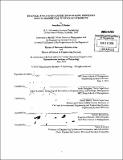| dc.contributor.advisor | Sarah Slaughter and David Marks. | en_US |
| dc.contributor.author | Dreher, Jonathan J. (Jonathan Jacob) | en_US |
| dc.contributor.other | Leaders for Global Operations Program. | en_US |
| dc.date.accessioned | 2010-10-12T17:47:11Z | |
| dc.date.available | 2010-10-12T17:47:11Z | |
| dc.date.copyright | 2010 | en_US |
| dc.date.issued | 2010 | en_US |
| dc.identifier.uri | http://hdl.handle.net/1721.1/59161 | |
| dc.description | Thesis (M.B.A.)--Massachusetts Institute of Technology, Sloan School of Management; and, (S.M.)--Massachusetts Institute of Technology, Engineering Systems Division; in conjunction with the Leaders for Global Operations Program at MIT, 2010. | en_US |
| dc.description | Vita. Cataloged from PDF version of thesis. | en_US |
| dc.description | Includes bibliographical references (p. 51-53). | en_US |
| dc.description.abstract | The convergence of the information age with an improved understanding of the effects humans have on the environment provides exciting new opportunities to improve our impact on the world. Though modem companies collect and store an increasing amount of environmental data, it often remains locked away after use in its intended, specific purpose. In many companies, this data remains unavailable despite its value in influencing critical decisions being made elsewhere in the organization. For example, though The Boeing Company has taken strides in incorporating environmental cost-benefit data when evaluating new environmental technology projects, a data gap between available data and data actually used for analysis still exists. This presents the opportunity for further data integration and the creation of a more standardized process for evaluating projects. The decision model outlined in this paper is designed specifically to fill in the data gaps identified in Boeing's current evaluation methodology and provide consistent data for objective decision making. The prototype software created to address this opportunity is designed to access existing data sets of cost benefit information for each possible environmental factor and use this data to provide thorough and consistent information for any project that effects environmental costs or benefits. The software also incorporates this data into standard financial evaluation metrics currently used to compare different project proposals. Initial tests of the prototype software developed in conjunction with this study yield improved financial attractiveness in three out of the three projects evaluated. The environmental data presented with the project proposals also provided key decision makers with more information for objective environmental decision making. Though no solution will integrate every detail or provide fully-automated decision making, this solution makes best use of the available data and presents it to key decision makers as a consistent part of all future project proposals. | en_US |
| dc.description.statementofresponsibility | by Jonathan J. Dreher. | en_US |
| dc.format.extent | 59 p. | en_US |
| dc.language.iso | eng | en_US |
| dc.publisher | Massachusetts Institute of Technology | en_US |
| dc.rights | M.I.T. theses are protected by
copyright. They may be viewed from this source for any purpose, but
reproduction or distribution in any format is prohibited without written
permission. See provided URL for inquiries about permission. | en_US |
| dc.rights.uri | http://dspace.mit.edu/handle/1721.1/7582 | en_US |
| dc.subject | Sloan School of Management. | en_US |
| dc.subject | Engineering Systems Division. | en_US |
| dc.subject | Leaders for Global Operations Program. | en_US |
| dc.title | Financial evaluation and decision making processes for environmental technology projects | en_US |
| dc.type | Thesis | en_US |
| dc.description.degree | S.M. | en_US |
| dc.description.degree | M.B.A. | en_US |
| dc.contributor.department | Leaders for Global Operations Program at MIT | en_US |
| dc.contributor.department | Massachusetts Institute of Technology. Engineering Systems Division | |
| dc.contributor.department | Sloan School of Management | |
| dc.identifier.oclc | 659560458 | en_US |
